
Theodor Seuss Geisel was an American children's author and cartoonist. He is known for his work writing and illustrating more than 60 books under the pen name Dr. Seuss. His work includes many of the most popular children's books of all time, selling over 600 million copies and being translated into more than 20 languages by the time of his death.

The Cat in the Hat is a 1957 children's book written and illustrated by the American author Theodor Geisel, using the pen name Dr. Seuss. The story centers on a tall anthropomorphic cat who wears a red and white-striped top hat and a red bow tie. The Cat shows up at the house of Sally and her brother one rainy day when their mother is away. Despite the repeated objections of the children's fish, the Cat shows the children a few of his tricks in an attempt to entertain them. In the process, he and his companions, Thing One and Thing Two, wreck the house. As the children and the fish become more alarmed, the Cat produces a machine that he uses to clean everything up and disappears just before the children's mother comes home.
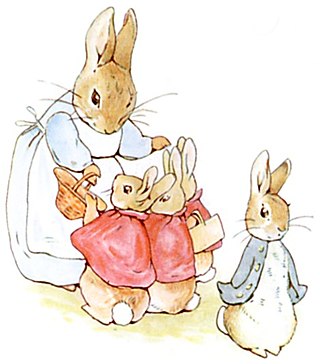
A picture book combines visual and verbal narratives in a book format, most often aimed at young children. With the narrative told primarily through text, they are distinct from comics, which do so primarily through sequential images. The images in picture books can be produced in a range of media, such as oil paints, acrylics, watercolor, and pencil. Picture books often serve as pedagogical resources, aiding with children's language development or understanding of the world.
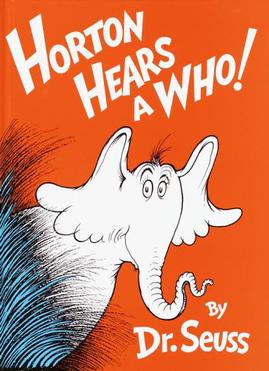
Horton Hears a Who! is a children's book written and illustrated by Theodor Seuss Geisel under the pen name Dr. Seuss. It was published in 1954 by Random House. This book tells the story of Horton the Elephant and his adventures saving Whoville, a tiny planet located on a speck of dust, from the animals who mock him. These animals attempt to steal and burn the speck of dust, so Horton goes to great lengths to save Whoville from being incinerated.

Green Eggs and Ham is a children's book by Dr. Seuss, first published on August 12, 1960. As of 2019, the book has sold 8 million copies worldwide. The story has appeared in several adaptations, starting with 1973's Dr. Seuss on the Loose starring Paul Winchell as the voice of both characters, and more recently an animated TV series of the same name on Netflix.

The Sneetches and Other Stories is a collection of stories by American children's author Dr. Seuss, published in 1961. It is composed of four separate stories with themes of tolerance, diversity, and compromise: "The Sneetches", "The Zax", "Too Many Daves", and "What Was I Scared Of?". Based on an online poll, the National Education Association listed the book as one of its "Teachers' Top 100 Books for Children". In 2012 it was ranked number 63 among the Top 100 Picture Books in a survey published by School Library Journal – the fifth of five Dr. Seuss books on the list.

Horton Hatches the Egg is a children's book written and illustrated by Theodor Geisel under the pen name Dr. Seuss and published in 1940 by Random House. The book tells the story of Horton the Elephant, who is tricked into sitting on a bird's egg while its mother, Mayzie, takes a permanent vacation to Palm Beach. Horton endures a number of hardships but persists, often stating, "I meant what I said, and I said what I meant. An elephant's faithful, one hundred percent!" Ultimately, the egg hatches, revealing an elephant-bird, a creature with a blend of Mayzie's and Horton's features.

And to Think That I Saw It on Mulberry Street is Theodor Seuss Geisel's first children's book published under the pen name Dr. Seuss. First published by Vanguard Press in 1937, the story follows a boy named Marco, who describes a parade of imaginary people and vehicles traveling along a road, Mulberry Street, in an elaborate fantasy story he dreams up to tell his father at the end of his walk. However, when he arrives home, he decides instead to tell his father what he actually saw—a simple horse and wagon.

Yertle the Turtle and Other Stories is a picture book collection by Theodor Seuss Geisel, published under his more commonly known pseudonym of Dr. Seuss. It was first released by Random House Books on April 12, 1958, and is written in Seuss's trademark style, using a type of meter called anapestic tetrameter. Though it contains three short stories, it is mostly known for its first story, "Yertle the Turtle", in which the eponymous Yertle, king of the pond, stands on his subjects in an attempt to reach higher than the Moon—until the bottom turtle burps and he falls into the mud, ending his rule.

Oh, the Places You'll Go! is a book written and illustrated by children's author Dr. Seuss. It was first published by Random House on January 22, 1990. It was his last book to be published during his lifetime. The book concerns the journey of life, its challenges and joys.

Hop on Pop is a 1963 children's picture book by Dr. Seuss, published as part of the Random House Beginner Books series. The book is subtitled "The Simplest Seuss for Youngest Use", and contains several short poems about a variety of characters designed to introduce basic phonics concepts to children.

McElligot's Pool is a children's book written and illustrated by Theodor Geisel under the pen name Dr. Seuss and published by Random House in 1947. In the story, a boy named Marco, who first appeared in Geisel's 1937 book And to Think That I Saw It on Mulberry Street, imagines a wide variety of fantastic fish that could be swimming in the pond in which he is fishing. It later became one of the Seuss books featured in the Broadway musical Seussical where its story is used for the song "It's Possible".
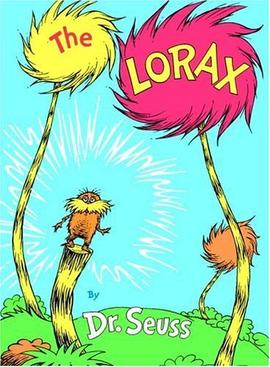
The Lorax is a children's book written by Dr. Seuss and published in 1971. It chronicles the plight of the environment and the Lorax, the titular character, who "speaks for the trees" and confronts the Once-ler, a business magnate who causes environmental destruction. Just like most Dr. Seuss works, most of the creatures mentioned are original to the book.

Beginner Books is the Random House imprint for young children ages 3–9, co-founded by Phyllis Cerf with Ted Geisel, more often known as Dr. Seuss, and his wife Helen Palmer Geisel. Their first book was Dr. Seuss's The Cat in the Hat (1957), whose title character appears in the brand's logo. Cerf compiled a list of 379 words as the basic vocabulary for young readers, along with another 20 slightly harder "emergency" words. No more than 200 words were taken from that list to write The Cat in the Hat. Subsequent books in the series were modeled on the same requirement.
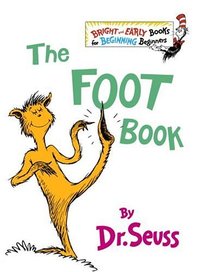
The Foot Book is a children's book written by Dr. Seuss and first published in 1968. Intended for young children, it seeks to convey the concept of opposites through depictions of different kinds of feet. The text of The Foot Book is highly stylized, containing the rhymes, repetitions, and cadences typical of Dr. Seuss's work.
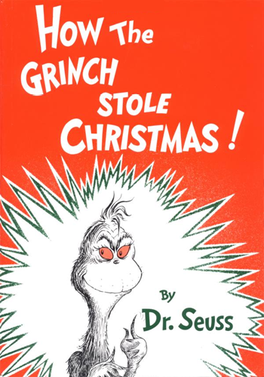
How the Grinch Stole Christmas! is a Christmas children's story by Theodor "Dr. Seuss" Geisel written in rhymed verse with illustrations by the author. It follows the Grinch, a grouchy, solitary creature who attempts to thwart the public's Christmas plans by stealing Christmas gifts and decorations from the homes of the nearby town of Whoville on Christmas Eve. Miraculously, the Grinch realizes that Christmas is not all about money and presents.
Theodor Seuss Geisel, better known as Dr. Seuss, published over 60 children's books over the course of his long career. Though most were published under his well-known pseudonym, Dr. Seuss, he also authored over a dozen books as Theo. LeSieg and one as Rosetta Stone.

One Fish, Two Fish, Red Fish, Blue Fish is a 1960 children's book by Dr. Seuss. As of 2001, over six million copies of the book had been sold, placing it 13th on a list of "All-Time Bestselling Children's Books" from Publishers Weekly. Based on a 2007 online poll, the United States' National Education Association labor union listed the book as one of its "Teachers' Top 100 Books for Children".
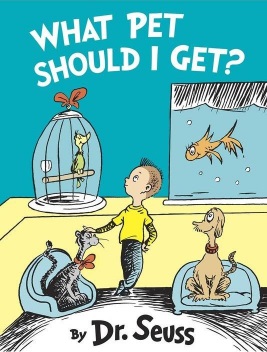
What Pet Should I Get? is a Dr. Seuss children's book, posthumously published in 2015. Believed to have been written between 1958 and 1962, the book chronicles the adventures of Jay and Kay from Seuss' One Fish, Two Fish, Red Fish, Blue Fish in their attempts to buy a pet.

Horse Museum is a Dr. Seuss book released by Random House Children's Books on September 3, 2019. It is based on an unfinished manuscript by Theodor Seuss Geisel completed by Australian illustrator Andrew Joyner. 250,000 copies were released of the first printing.



















